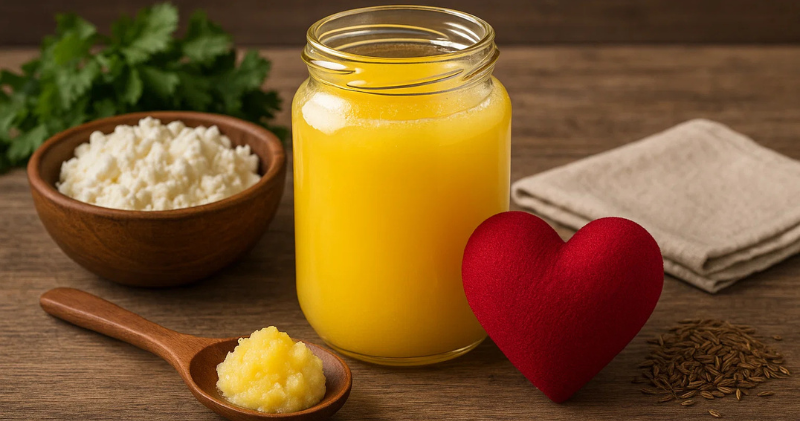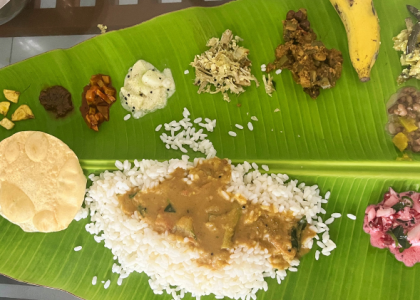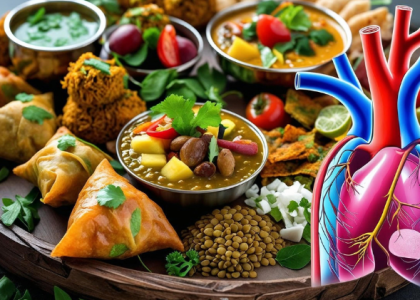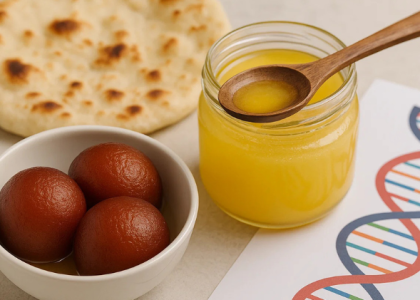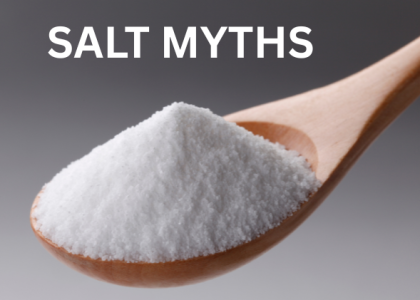Walk into any South Asian kitchen, and you’ll likely find a jar of golden ghee sitting proudly on the counter. This clarified butter has been the heart of Indian cooking for thousands of years. It lights our temple lamps, flavors our rotis, and carries the prayers of generations.
But here’s the question many of us are asking today: Is our beloved ghee helping our hearts or hurting them?
This question is especially important for South Asians. Research shows that people of South Asian descent have 3-5 times higher rates of heart disease compared to other ethnic groups, even when living abroad. We develop heart disease earlier (often before age 40) and experience more severe complications.
Let’s explore this together – without judgment, but with facts.
Ghee: More Than Just Fat
For our ancestors, ghee wasn’t just cooking oil. It was medicine, offering, and symbol of prosperity all rolled into one golden spoonful.
In Ayurveda, ghee is considered a “sattvic” food – pure and balancing. Ancient texts praise it for improving digestion, boosting immunity, and even enhancing memory. Our grandmothers fed it to babies for healthy growth and applied it to wounds for healing.
In our temples, ghee fuels the sacred flames. We offer it to deities because it represents the purest form of nourishment. During festivals like Diwali, ghee lamps light up our homes and hearts.
In our kitchens, ghee transforms simple dal into a feast. That tadka (tempering) of ghee with cumin and mustard seeds? It’s not just flavor – it’s tradition speaking.
But times have changed. We’re more sedentary. Our portion sizes are bigger. And heart disease has become a serious concern in South Asian communities.
What Exactly Is Ghee?
Think of ghee as butter’s concentrated cousin. When you heat butter and remove all the water and milk solids, what remains is pure butterfat – ghee.
Here’s what’s inside ghee:
- 62-65% saturated fat (the kind that’s been controversial)
- Butyric acid (good for gut health)
- Conjugated linoleic acid (CLA) (may help with inflammation)
- Vitamins A, D, E, and K (fat-soluble vitamins our bodies need)
One tablespoon of ghee contains about 14 grams of fat and 120 calories. That’s similar to any cooking oil, but the type of fat is different.
The Heart of the Matter: Cholesterol Talk
Let’s talk about cholesterol in simple terms. Think of your blood as a highway, and cholesterol as cars traveling on it.
LDL cholesterol = the “bad” cars that can cause traffic jams (blockages) in your arteries HDL cholesterol = the “good” cars that help clear the traffic
Here’s what research shows about ghee:
- It raises both LDL and HDL cholesterol
- For some people, the LDL increase matters more (especially if you already have high cholesterol or family history of heart disease)
- The HDL increase is good, but it doesn’t cancel out the LDL increase
This is important for South Asians because we have higher rates of heart disease compared to other groups, even at younger ages. Studies show that South Asians have smaller, denser LDL particles that carry more ApoB (a protein that makes cholesterol particles more dangerous). This means even moderate LDL increases can be more harmful for us than for other populations.
Ghee vs. Modern Oils: The Comparison
“But ghee is natural! It must be better than processed oils,” you might think.
Here’s the reality:
Ghee advantages:
- No trans fats (unlike some processed oils)
- High smoke point (good for cooking at high heat)
- Contains beneficial compounds like CLA and butyric acid
- Lactose-free (good for those who can’t digest dairy)
Modern oil advantages:
- Oils like olive, canola, and sunflower contain less saturated fat
- Some oils (like olive oil) have proven heart benefits
- Generally lower in calories per tablespoon
The truth? Neither ghee nor any single oil is perfect. The key is how much you use and what else you eat.
Busting Common Ghee Myths
Myth 1: “Ghee doesn’t raise cholesterol” Reality: Multiple studies show ghee does raise cholesterol levels, particularly LDL. A 2022 study comparing ghee to olive oil found that ghee increased ApoB (a marker of harmful cholesterol particles) and non-HDL cholesterol compared to olive oil.
Myth 2: “My grandmother ate ghee daily and lived to 90” Reality: Our grandparents also walked more, ate smaller portions, consumed more fiber, and had less processed food. Their overall lifestyle was different.
Myth 3: “Ghee cures diabetes and heart disease” Reality: While ghee has some beneficial compounds, it’s not medicine. No single food cures complex diseases.
Myth 4: “All saturated fat is the same” Reality: This is still being researched. Some studies suggest moderate consumption of ghee may not increase cardiovascular risk factors in the general population, but more research is needed.
So, How Much Ghee Is Okay?
Here’s practical advice based on current research:
For most healthy adults:
- 1-2 teaspoons per day is likely fine
- Focus on how you use it – tempering and flavoring, not deep frying
You should limit or avoid ghee if you have:
- High cholesterol (especially LDL above 100 mg/dL)
- High ApoB levels (above 90 mg/dL) – a newer, more accurate heart disease marker
- Family history of early heart disease
- Diabetes with other risk factors
- South Asian ancestry with multiple risk factors (we’re at higher baseline risk)
The best approach:
- Use ghee mindfully – for special dishes and flavoring
- Balance it with plenty of vegetables, whole grains, and fiber
- Stay active – exercise helps your body handle saturated fats better
- Get regular check-ups – know your cholesterol numbers
Smart Ways to Enjoy Ghee
Better choices:
- Add a teaspoon to finished dal or vegetables
- Use for tempering spices
- Drizzle small amounts on chapati
- Save larger amounts for special occasions
Less ideal choices:
- Deep frying foods in ghee
- Adding ghee to already oily dishes
- Using ghee as your only cooking fat
- Eating ghee-heavy sweets regularly
The Bottom Line
Ghee is like a treasured family guest – honored and welcome, but doesn’t need to stay for every meal.
The science suggests:
- Ghee has both benefits and risks
- Small amounts (1-2 teaspoons daily) are likely fine for most people
- People with heart disease risk factors should be more careful
- It’s not a superfood, but it’s not poison either
The cultural reality:
- Ghee connects us to our heritage
- Complete avoidance isn’t necessary for most people
- Moderation and balance are key
Your action plan:
- Know your numbers – get your cholesterol checked
- Be honest about portions – measure your ghee use for a week
- Balance your plate – more vegetables, whole grains, and fiber
- Stay active – regular exercise helps your heart handle fats better
- Talk to your doctor – especially if you have family history of heart disease
Remember, health isn’t about perfection. It’s about making informed choices that honor both our bodies and our culture.
Our ancestors gave us ghee as a gift. The best way to honor that gift is to use it wisely – with knowledge, moderation, and respect for our hearts.
What matters most is not whether you eat ghee, but how you live your whole life. Make room for tradition, but also make room for health.
References:
- Kumar MV, Sambaiah K, et al. Effect of dietary ghee on serum lipid levels and microsomal lipid peroxidation. Ayu 2011;32(2):171-6.
- Nirmala J, Hamblin SM. Effects of diets rich in ghee or olive oil on cardiometabolic risk factors in healthy adults. British Journal of Nutrition 2022;128(2):274-280.
- Volgman AS, Palaniappan LS, et al. Atherosclerotic cardiovascular disease in South Asians in the United States. Circulation 2018;138:e1-e34.
- American Heart Association. Scientific Statement on South Asian Heart Health, 2018.
